SOILS OF INDIA – FORMATION, CLASSIFICATION AND CONSERVATION
(EXCLUSIVELY FOR CLASS X STUDENTS AND NTSE ASPIRANTS)
Soils of India is the last topic of the first chapter of Geography in class X. It includes soil profile, types of soils, soil erosion and its conservation methods. Soil is a very important renewable resource. It acts as a medium of plant growth and supports different types of living organisms.https://shapingminds.in/class-ix-geograp…d-ntse-questions/ Soil is a living organic material which takes millions of years in its formation. In India, the soil types varies from one region to other making the soils of India interesting. An important topic for CBSE Board exam and other competitive examinations. https://shapingminds.in/ntse-ii-class-x-geography/ In this article, you will know everything in details http://www.yourarticlelibrary.com/soil/soil-groups-8-major-soil-groups-available-in-india/13902 but point wise about the soils of India.
FACTORS RESPONSIBLE FOR THE FORMATION OF SOIL:
a) RELIEF FEATURES: Parent rock, vegetation, climate and time are the important factors in the formation of soil.
b) NATURAL FORCES: Running water, high or low temperature, wind, glaciers etc.
c. Chemical and organic (humus) changes also play a major role in the formation of soil.
Many people think that sand is also a type of soil but it is not. Let’s understand the difference between sand and soil.
DIFFERENCE BETWEEN SOIL AND SAND:
- soil has life but sand doesn’t have life.
- Humus is present in soil but not in sand.
- soil has micro-organisms but these are not present in sand.
- It has different colours but sand has only one colour.
- soil has layers, profile, texture, nutrients, fertility but sand lacks these properties.
PHYSICAL PROPERTIES OF SOIL:
- TEXTURE:
What do you mean by the texture of soil?
When you go to purchase clothes in the market, you definitely touch the clothes to know it’s quality. You may find some clothes with matte finish and some as silky. Same is true with the colours (abeer or gulal) which is used during Holi in India. How do we feel when we touch. That defines the texture of the soil. Texture of the soil mainly deals with three components present in the soil. They are:
a. sand – In Hindi we call it (बलुआ मिटटी). When the soil has more than 33% of sand, it is called sandy soil. It’s particle size may be from (0.5 to 0.1 mm in diameter)
b. silt – In Hindi we call it ( गाद ). When the soil has more than 33% of silt, it is called silty soil. It is finer than the sandy soil. It’s particle size may be from (0.1 to 0.002 mm)
c. clayey _ In Hindi we call it ( चिकनी मिटटी ) When the soil has more than 33% of clay, it is called clayey soil. It’s particle size may be lesss than (0.002 mm diameter)
and if the soil has all the three nutrients evenly distributed ( sand,silt and clay) then it is called Loamy soil In Hindi we call it दोमट मिटटी, which makes it very fertile.
so, whichever component exceeds in the soil that forms the nature (texture) of the soil.
2. COMPOSITION OF SOIL: Shape of the particles of soil determines the composition of soil. The shape of particles may be circular, triangular, prismatic etc.
SOIL PROFILE :
Generally layering of the soil is known as soil profile. It is where the secrets of soil are hidden. Most soil profiles are series of Horizons / layers of soil stacked on top of one another like layer of cakes. Dig down deep into any soil and you will see that it is made of layers/ horizons (OABCR). Most soils may have only three Horizons but some may have up to five.
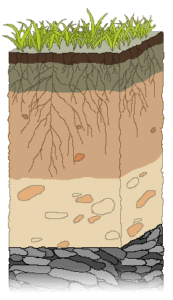
DIFFERENT LAYERS OF SOIL
I) “O” HORIZON (HUMUS OR ORGANIC): It is the topmost layer mostly composed of organic matter like decomposed leaves. It may be thin or thick depending upon the soil and may be absolutely absent in some soil. It is the layer where roots of small grasses can be found. Mostly found in black or brown colour.
ii) “A” HORIZON: It consists of top soil which contains minerals along with organic material. It can be seen in the absence of “O” Horizon. Good for plants and other organisms.It is mostly made up of sand, silt and clay with high amount of organic matter.
iii) “E” HORIZON: The minerals which get washed down (Leached) from the “A” Horizons get accumulated here. It is often called as sub-soil.
iv) “C” HORIZON: Deposits on the earth’s surface from which the soil developed.
v) “R” HORIZON: Also known as bed-rock. Initially when the rock is formed it is hard and non-porous. It is the parent rock. It can be Basalt, Limestone, Quartz, sandstone etc.
TYPES OF SOILS IN INDIA:
- ALLUVIAL SOIL:
i) covers 42% of Indian landmass.
ii) mainly deposited by rivers in it’s flood plains.
iii) extremely fertile soil rich in organic material.
iv) well drained i.e. has good water holding capacity.
v. mainly found in Northern plains and eastern coastal plains mainly in the delta regions.
DRAWBACK: Lacks Phosphorous.
INTERESTING FACT: The soil in the eastern part of the Northern plain (Bihar, Bengal and Assam) are more fertile than the soil found in Punjab and Haryana but the production of crop is more in the western parts.
2. RED SOIL:
i) covers 25% of Indian landmass.
ii) most widespread soil ( covers a very large area)
iii) formed due to the erosion of gneiss and ignite rocks which has iron (Fe) and Nickle (Ni).
iv) due to presence of iron it looks red in colour.
v) best drained soil because of it’s water holding capacity.
vi) it is rich in iron, lime, phospate ,potash
vii) can support maximum food crops (diversity) like rice, pulses, fruits, vegetables etc.
viii) therefore, important for food security and nutritional balance.
DRAWBACK:
a) LACKS IN NITROGEN AND PHOSPHOROUS
b) MOST VULNERABLE TO SOIL EROSION.
c) TOP SOIL IS MOSTLY USED IN BRICK MAKING.
3. BLACK SOIL:
i) covers 15% of the total area of India.
ii) formed due to the weathering of lava rocks of Deccan plateau.
iii) Black colour due to the weathering of black Basalt rock.
iv) rich in ferro-magnesium, lime and potash.
UNIQUENESS:
a. high clay content provides the best water retention (holding) capacity.
b. develops cracks during dry spells which allows air to enter in the depth which allows self aeration.
c. best suitable for growing cotton.
DRAWBACK:
LACKS NITROGEN AND PHOSPHOROUS.
OTHER TYPES OF SOILS IN INDIA ARE:
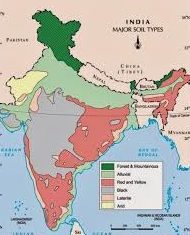
SOILS OF INDIA – MAP
4. LATE-RITE SOIL:
i) covers 4.5% area.
ii) found in the regions of alternate wet and dry seasons.
iii) literal meaning of Late-rite is brick due to its hardness.
iv) formed by the process called Leaching due to downward movement of minerals due to heavy rainfall.
v) excessive iron is found in this soil.
vi) best suitable for two plantation crops i.e. Tapioca and Cashew-nuts. Also supports Tea, Rubber and Coffee.
DRAWBACKS:
LACKS MINERALS THEREFORE NOT SUITABLE FOR AGRICULTURE.
5. MOUNTAINOUS SOIL:
i) mostly found in dry and cold regions of Himalayas like Kashmir, Sikkim, Arunachal Pradesh etc.
ii) very thin layer of soil.
iii) soil is found at steep gradient thus doesn’t support agriculture.
6. DESERT SOIL:
i) it is sandy and loose soil with poor water retaining capacity.
ii) Lacks all type of nutrients thus infertile.
iii) Indian Thar desert soil is unique because it is made up of Alluviam fine loessic deposits. It is dry just because of less rainfall .
iv) rich in micro-nutrients.
SOIL EROSION:
Soil erosion can be defined as wearing away of the top layer of the soil. It can be eroded by wind, water, rainfall etc.The top most layer of soil is highly vulnerable. Three steps are involved in soil erosion. They are Detachment, Movement and Deposition.
TYPES OF SOIL EROSION:
i) SHEET EROSION:
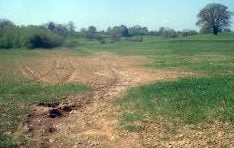
SHEET EROSION
Removal of thin uniform covering of top surface soil from
large areas during every rain which produces a run-off.
It keeps the farmers ignorant about its ill effects.
ii) RILL EROSION:
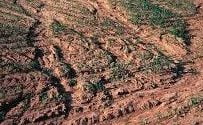
RILL EROSION
When run-off starts, channelization begins and the erosion is no longer uniform.
Rills are the small channels which carries away the soil.
iii) GULLY EROSION:
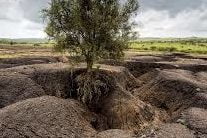
GULLY EROSION
It is a more prominent type of erosion in which due to heavy rainfall,
fast flowing river may result in deeper cavities called gullies.
In India, Chambal river has made 3 lac hectare kilometre of land unfit for cultivation.
iv) RAVINE EROSION:
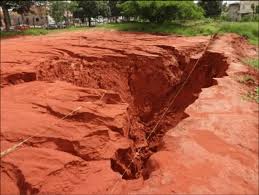
RAVINE EROSION
It is the next level of Gully erosion.
In this type of erosion, water cuts the land deep and wide, which is known as Ravines.
HUMAN FACTORS RESPONSIBLE FOR SOIL EROSION:
i) DEFORESTATION
ii) OVER GRAZING
III) CONSTRUCTION WORK
iv) MINING and
v) DEFECTIVE METHODS OF FARMING.
TYPES OF SOIL CONSERVATION MEASURES:
1 CONTOUR PLOUGHING:
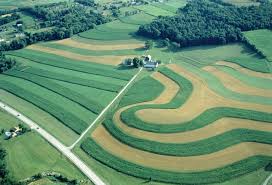
CONTOUR PLOUGHING
Ploughing along the contour lines can decelerate the
flow of water down the slopes in hilly regions.
Reduces the formation of rills and gullies.
It reduces soil erosion.
2. TERRACE FARMING:
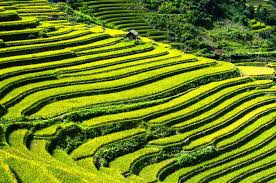
Terrace means stairs.Small steps are cut over the mountain slopes to reduce
the flow of water and restrict erosion.
Farming is done on flat surface.
It alters the shape of the slope to produce flat areas.
3. STRIP CROPPING:
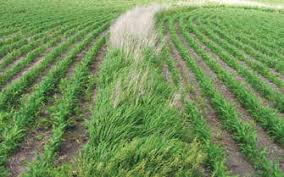
STRIP CROPPING
In strip cropping, grasses are grown between the crops.
This breaks up the force of the wind and protects the soil.
It creates natural dams for water.
Mainly practiced in areas where the slope is very steep.
4. SHELTER BELTS:
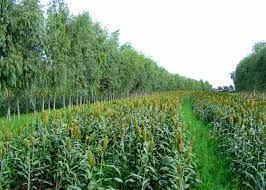
SHELTER BELTS
Planting trees in a line to create shelter also obstructs the flow of wind and water,
hence, protects the soil. It has contributed significantly to the stabilization of sand dunes.
They are planted mainly to protect crops or animals from cold winds but also to give
shade in hot weather. It also reduces the wind force.
5. AFFORESTATION:
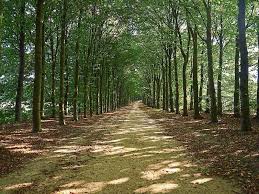
AFFORESTATION
The word Afforestation means planting of trees.
As we know that deforestation makes the soil loose and help in erosion. similarly,
by afforestation,
the roots of the trees will bind the soil and reduce the chance of erosion.




0 Comments